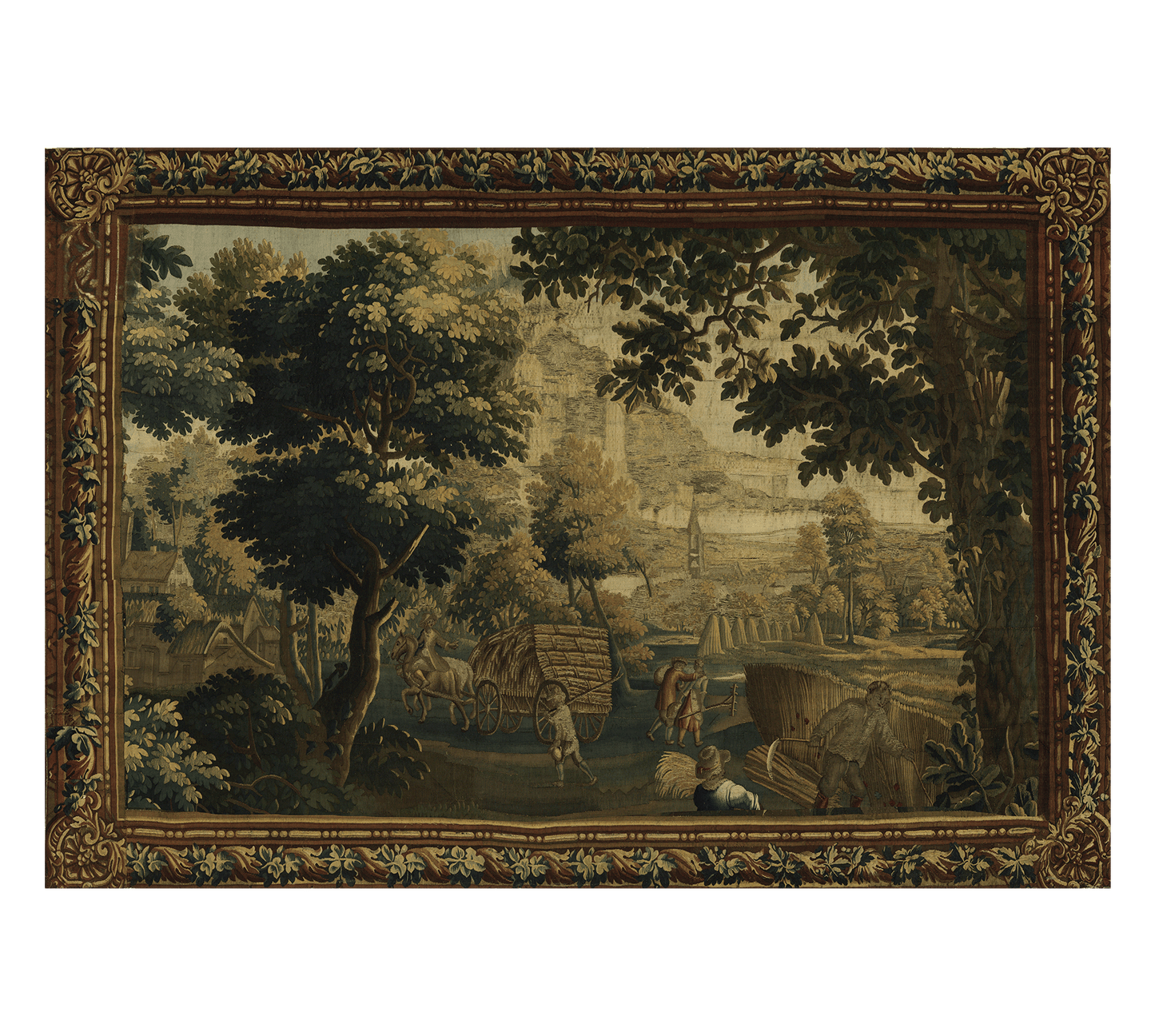Romantic English
The Harvest's Bounty RE121743
The Harvest's Bounty RE121743
Couldn't load pickup availability
This tapestry, rich with pastoral charm, captures the essence of rural labor and the serene beauty of the countryside. Allow me to describe it with the reverence and detail it deserves.
Title: "The Harvest's Bounty"
Foreground and Main Scene: In the foreground, we are presented with a tranquil scene of harvest in full swing. The figures, though small and almost secondary to the landscape, are engaged in the timeless task of reaping and gathering. A man in a simple, rustic outfit bends low, his scythe poised to cut another swath of golden wheat. His movements are deliberate and practiced, a reflection of years spent working the land. Nearby, another figure, perhaps his wife, is gathering the sheaves, her form hunched slightly from the weight of the harvest and the toll of labor.
A large, wooden cart, filled to the brim with bundles of wheat, stands in the center of the scene, its wheels thick and sturdy, well-suited for the heavy load it bears. The horses, strong and patient, are ready to haul the cart back to the barn once it is fully loaded. The cart, with its rustic charm, serves as a focal point, drawing the eye to the fruits of the labor that dominates the scene.
Background and Setting: The background of the tapestry extends far into the distance, revealing a sweeping landscape that is both idyllic and meticulously detailed. The trees, with their thick canopies, create a sense of enclosure, a natural frame that guides the viewer’s gaze deeper into the tapestry. Their leaves are depicted with an exquisite attention to detail, each one contributing to the overall texture and richness of the scene.
Beyond the trees, a small village comes into view, its cottages nestled among the greenery. The thatched roofs and stone walls of the buildings are typical of rural architecture, blending seamlessly with the natural surroundings. The village is peaceful, almost sleepy, its inhabitants likely occupied with similar tasks as those in the foreground.
Further still, a grand castle looms in the distance, its towers and walls bathed in the soft light of the setting sun. This castle, though far removed from the labor of the fields, symbolizes the broader world that these villagers are a part of—a world where the fruits of their labor might one day feed the mouths within those stone walls. The castle is a reminder of the feudal ties that bound the rural and noble classes together, each dependent on the other in the cycle of life.
The Harvest: The harvest scene is depicted with a quiet reverence, each figure absorbed in their task. There is a sense of rhythm and continuity, as if the scene captures just one moment in an ongoing cycle that has been repeated for generations. The act of harvesting is portrayed not as a burden, but as a vital and respected part of life, one that is intimately tied to the land and the changing seasons.
Border: The border of the tapestry is decorated with floral motifs and leaves, echoing the natural elements within the main scene. The colors of the border—rich browns, deep greens, and touches of gold—complement the earthy tones of the central image, creating a harmonious frame that enhances the overall warmth and richness of the tapestry.
Color and Technique: The colors are muted yet rich, with earthy browns, greens, and golden yellows dominating the palette. The artist has skillfully used shading and light to create depth and dimension, particularly in the foliage and the distant castle. The weaving is finely executed, with delicate details that bring the scene to life—the texture of the wheat, the folds of the figures’ clothing, and the intricate leaves of the trees all contribute to the tapestry’s overall sense of realism and beauty.
The technique used is likely from a highly skilled workshop, perhaps from Flanders or France, known for their exquisite tapestries in the 17th or 18th centuries. The care taken in depicting the figures and landscape suggests that this tapestry was created not just as a decorative piece, but as a celebration of rural life and the beauty of the natural world.
Interpretation: "The Harvest's Bounty" is a tapestry that speaks to the simple yet profound connection between people and the land. It celebrates the harvest as a time of hard work, yes, but also of fulfillment and community. The figures, though small, are the heart of the scene, embodying the virtues of diligence, patience, and reverence for the earth.
This tapestry would have served as a reminder of the beauty and importance of rural life, perhaps hung in a grand home where the land’s produce was consumed and appreciated. It is a piece that brings warmth and a sense of peace, inviting the viewer to reflect on the rhythms of life that connect us all to the earth.
"The Harvest's Bounty" is a tapestry that captures the essence of pastoral life with grace and dignity. It is a celebration of the harvest, not just as an agricultural activity, but as a vital, life-sustaining ritual that has shaped human existence for centuries. The tapestry stands as a testament to the enduring beauty and value of rural life, a theme that resonates as deeply today as it did when this work was first created.
RE121743
Share


